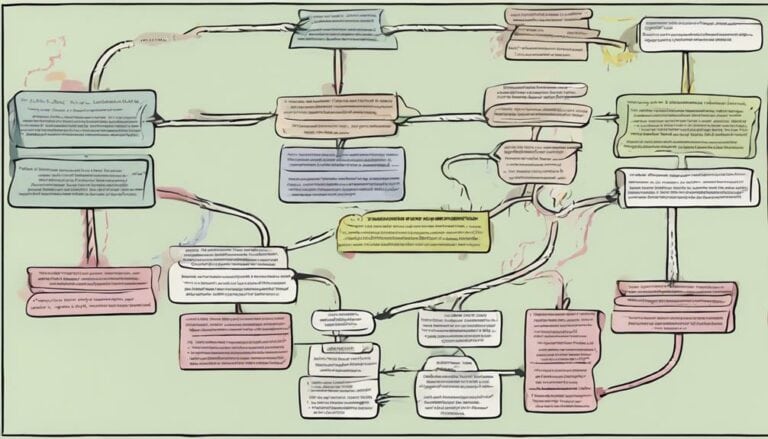In exploring how decision-making models vary across different leadership styles, you'll find that each approach brings its own unique dynamics to the table. From the decisive nature of autocratic leadership to the collaborative essence of democratic styles, the way decisions are reached can have a profound impact on team dynamics and outcomes.
But what about the less conventional laissez-faire and transformational leadership styles? How do they influence the decision-making process and ultimately shape the organizational landscape?
Let's uncover the nuances of decision-making models within diverse leadership frameworks and the implications they hold for teams and success.
Key Takeaways
- Autocratic leadership centralizes decision-making for efficiency.
- Democratic leadership values diverse perspectives through group discussions.
- Laissez-faire leadership promotes innovation with decentralized decision-making.
- Transformational leadership combines rational decisions with visionary goals.
Rational Decision-Making in Different Leadership Styles
When examining the role of rational decision-making within various leadership styles, it becomes apparent that each style dictates a distinct approach to how decisions are formulated and executed. In autocratic leadership, rational decision-making is centralized, with the leader autonomously making logical choices without much input from subordinates. This style emphasizes efficiency and quick decision-making processes.
Conversely, democratic leadership involves rational decision-making through group discussions and weighing options collectively. This approach values diverse perspectives and fosters a sense of inclusivity among team members.
Laissez-faire leadership may lead to decentralized rational decision-making, where team members have the autonomy to make choices within their domains. While this can cultivate innovation and independence, it also requires a high level of trust and competence among team members.
Transformational leadership integrates rational decision-making with visionary goals and innovative strategies, aiming for impactful outcomes that inspire and motivate followers. Servant leadership combines rational decision-making with a focus on meeting the needs and valuing the perspectives of team members, creating a supportive and nurturing environment for decision-making processes.
Intuitive Decision-Making Approaches by Leaders
Leaders utilizing intuitive decision-making approaches draw upon past experiences and instincts to steer complex situations efficiently and effectively. This method allows for quick decisions when time is limited, relying on a leader's gut feeling or intuition rather than extensive analysis.
Experience and knowledge are key components in the effectiveness of intuitive decision-making, as leaders draw on their past encounters to guide them. Making decisions based on intuition can be particularly valuable in ambiguous or complex situations where traditional analytical methods may fall short. By tapping into their intuition, leaders can swiftly assess the best course of action, leveraging their expertise and instincts to guide results.
This approach underscores the importance of honing one's intuition through continuous learning and exposure to diverse scenarios, enabling leaders to make sound judgments even when faced with uncertainty. Intuitive decision-making stands as a valuable tool in a leader's arsenal, complementing rational approaches and offering a unique perspective in steering the intricacies of leadership.
Vroom-Yetton Model Variations in Leadership
The Vroom-Yetton Model of decision-making in leadership offers a structured framework that guides leaders in determining the appropriate level of team involvement required for effective decision-making processes. This model is particularly beneficial for managers and leaders who need to navigate complex scenarios by understanding the nuances of collaborative decision-making. By utilizing a structured approach, leaders can assess the level of team involvement necessary to make informed decisions efficiently.
| Vroom-Yetton Model Variations | Decision-Making Processes | Leadership Styles |
|---|---|---|
| Contingent Autocratic | Leader makes decisions alone | High task structure, low team involvement |
| Consultative | Leader consults with team members before making a decision | Moderate task structure, high team involvement |
| Group | Leader involves the team in decision-making process | Low task structure, high team involvement |
Recognition-Primed Decisions Across Leadership Styles
Analyzing past experiences to recognize patterns and inform decision-making, recognition-primed decisions are a valuable tool across various leadership styles. This decision-making model leverages leaders' experience and instinct to swiftly navigate complex situations.
By analyzing past situations, leaders can identify recurring patterns, enabling them to determine the best course of action efficiently. Utilizing their expertise and intuition, leaders employing recognition-primed decisions can make quick and effective choices in diverse scenarios.
This model is particularly beneficial in time-sensitive situations where immediate action is critical. It emphasizes the significance of drawing upon past experiences to guide decision-making processes effectively.
Leaders across different styles can benefit from this approach, as it allows for agile decision-making based on a deep understanding of past occurrences and their outcomes. Recognition-primed decisions provide a structured yet flexible method for leaders to navigate challenging scenarios confidently and make well-informed choices swiftly.
Creative Decision-Making in Leadership Applications
Engaging in innovative problem-solving approaches, creative decision-making in leadership fosters a culture of originality and collaboration within teams. When leaders embrace creative decision-making, they tap into the potential of their teams to generate fresh ideas and innovative solutions. Here are some key aspects of creative decision-making in leadership applications:
- Original Ideas: Leaders encourage team members to think outside the box and come up with new and original concepts to address challenges.
- Team Collaboration: Collaboration is essential in creative decision-making, as it leverages the diverse perspectives and skills of team members.
- Out-of-the-Box Thinking: This approach pushes teams to explore unconventional solutions that may lead to breakthroughs and competitive advantages.
- Innovative Solutions: By fostering a culture of creativity, leaders enable teams to develop unique and effective solutions to complex problems.
Conclusion
You have explored how decision-making models vary across leadership styles, impacting team dynamics and organizational success.
Did you know that 70% of employees feel more engaged when they're involved in decision-making processes?
Understanding these differences can help leaders effectively engage their teams and make strategic decisions that drive success.
Keep in mind the importance of involving team members in decision-making to foster motivation and creativity in your organization.

